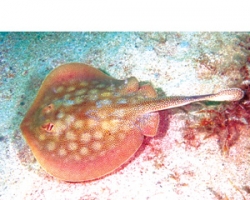Seal Beach was one of the birthplaces of modern surfing and also surf music. It’s said that the seminal surf band The Safaris’ instrumental “Walk Don’t Run” was written in the seaside city.
Now there’s a new song for the surf beach known as “Ray Bay.” It’s called the “Stingray Shuffle” and according to Seal Beach Lifeguard Chief Joe Bailey, it’s a good one to know if you are heading into the ocean at Seal Beach, especially if you want to avoid the stingrays that populate the area and their sting that is said to be much more painful that a bee sting.
Seal Beach has what appears to be one of the highest concentrations of the round stingrays of any popular beach-going destination.
In fact, one-third of the nation’s stingray injuries have been reported along Seal Beach, according to Bailey. He says the stingrays are attracted to Seal Beach in part because of warmer water near the mouth of the San Gabriel River. A power plant located in the beach city raises ocean temperatures slightly, making for an appealing environment for the rays.
The population seems to be on the rise.
In 2008, as many as 500 stings were reported in Seal Beach. It was the highest number in a decade and nearly doubled the recorded number of stings in 2006.
This year could produce the highest number of stings yet. In one spike in the number of incidents, Seal Beach lifeguards treated 147 stingray injuries between Friday, July 1 and Thursday, July 7. On Saturday, July 2 alone lifeguards treated 35 sting victims and at times the lifeguard station near the Seal Beach Pier looked somewhat like a hospital in a war zone.
The phenomenon is now the subject of a special study by scientists from Cal State Long Beach, volunteers from the Learn2Surf Academy and Seal Beach lifeguards. They have been catching hundreds of the stingrays in nets, removing their barbs, tagging them and releasing them back into the water.
So far, they have recaptured only a small number of the tagged rays, leading them to an initial conclusion that there are anywhere from 16,000 to 40,000 or possibly many more stingrays that make their home in Seal Beach waters. The study is still underway and final results are not expected for up to a few months.
Bailey said lifeguards are putting up signs near the west end of the pier warning swimmers and surfers about the stingray danger.
He advises swimmers to do the “stingray shuffle” when entering the water, which involves keeping feet planted in the sand and moving them back and forth.
If you are stung, putting your foot in a bucket of hot water will neutralize the ray’s venom, Bailey said.
The round stingray, Urolophus halleri, is the most common stingray found in Southern California waters. It typically inhabits sand or mud substratum off coastal beaches, bays, and sloughs.
“They like brackish water, like what comes out of the river and mixes with the salt water,” Bailey said. “It’s a perfect environment for them.”
The stingray gains its name from the poisonous serrated spine located towards the base of its tail, which it uses to defend itself, such as when it is stepped on by an unsuspecting human. Because of human population increases along coastal areas, more people are participating in ocean recreation activities and are going to the beach. As the result of these apparent overlaps in habitat use between stingrays and humans, increased numbers of stingray-related injuries have been reported from beaches in Orange County, California; especially during the summertime.
“The number of cases go up throughout the summer,” Bailey said. “The number goes up when the water is calm,” Bailey said. “When there is little or no surf, the stingrays move closer to shore. Last week we had surf and the stingrays moved off shore.”
Bailey said that treating stingray injuries stretches his staff, whose main job is to protect people from drowning. On a recent day with many stingray incidents, Bailey said he had three lifeguards treating victims.
“We ran out of hot water and had to heat some up using a microwave oven and we needed to buy more buckets at Bay Hardware,” Bailey said. “They definitely can be a drain on our resources.”
For all of their negative side affects, Bailey said that some people like the stingrays because they find them delicious.
“I think they make artificial scallops out of them,” Bailey said. “I’ve heard some people really do like to eat them.”
Regardless of the stingray as food, Bailey’s job is to help keep people safe when they enter the water. He said the lifeguards have been placing stingray warning signs in the area and doing their best to keep bathers and waders closer to the pier and shore where they are less likely to be stung.
While there can be some serious injuries from a stingray sting from their barbs that often measure about two inches long, Bailey said most of the stings that are treated early heal quickly. However, stings that are not treated can fester and cause such things as losing a toenail.
Some people are also allergic to the stingray sting and could go into anaphylactic shock.
“Over the 20 years I’ve heard these stories, I‘d say that 90 percent of the injuries heal up pretty quickly,” Bailey said.
Due to the number of stingrays, people are advised that anytime when entering the ocean at Seal Beach that they “Walk, Don’t Run.” And do “The Sting Ray Shuffle.”
“The Sting Ray Shuffle” was written by Gary Snow of Seal Beach, a surfer and musician who performs the song with his band Deuce Coupe. The words are listed below:
The Sting Ray Shuffle
Goin’ down to Seal Beach
We’re goin’ surfin’ today
If we’re lucky, the waves will be good at Sting Ray Bay
Well, there’s warm water runnin’ in from the river
It’s a wonderful thing
But ya gotta shuffle your feet or you’re gonna get a sting
Do the Sting Ray Shuffle
Do the Sting Ray Shuffle
Ya better do that thing
Or you’re gonna get a sting.
Do the Sting Ray Shuffle
Do the Sting Ray Shuffle
If you’re gonna have fun
It’s Rule Number One
Well, there’s ten thousand sting rays swimmin’ around
From the river to the pier’
But you really can’t see them
‘Cause the water’s not too clear
But if you fall off your board
And step on a creature
On the bottom of the bay
Then get ready for a big hello
From Mister Sting Ray
If one of them stings you and you go to the Life Guard
This is what he’ll say
Soak it in hot water and the pain will go away
If you’re walking in the water shuffle your feet
Or you’re gonna be sad
If a sting ray gets you it’s for sure
It’s gonna be bad.
Note: A video of Gary Snow singing the “Stingray Shuffle” can be found in the video gallery here at www.sunnews.org.












